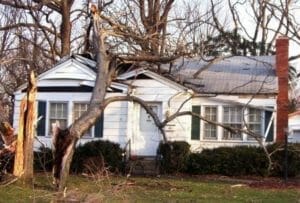Recent storms have left many Portland trees in a sad state. High winds and ice storms often break branches, opening the tree to disease. Moreover, maelstroms may knock down entire trees—as one unfortunate cyclist recently learned in downtown Portland, when a tree fell on her. In this post, we take a look at what to do if your trees have suffered storm damage. We also discuss how to spot hazard trees—those that are liable to fall in upcoming inclement weather. Finally, we talk about how to prevent damage in future storms.
 Tree Damage and Storms. High winds may damage trees, especially older specimens and those with large crowns. When inspecting trees for damage after a storm, be extremely cautious. Look out for downed power lines—if you see downed wires, stay at least 30 feet away, and notify the power company. Additionally, if a branch is dangling precariously, contact an arborist. Portland ISA certified arborists have the tools and the expertise to safely remove hanging limbs. In addition to post-storm pruning, Urban Forest Pro’s arborists can provide Portland tree removal.
Tree Damage and Storms. High winds may damage trees, especially older specimens and those with large crowns. When inspecting trees for damage after a storm, be extremely cautious. Look out for downed power lines—if you see downed wires, stay at least 30 feet away, and notify the power company. Additionally, if a branch is dangling precariously, contact an arborist. Portland ISA certified arborists have the tools and the expertise to safely remove hanging limbs. In addition to post-storm pruning, Urban Forest Pro’s arborists can provide Portland tree removal.
Trees do have a remarkable ability to heal, and some damage is inevitable. For trees with light damage, first aid measures are available. If major limbs or upward leader branches are broken, it will be harder for the tree to respond, and it may not be able to survive. If most of the branches are broken, or the upward leader limb has been severed, it will be very difficult for the tree to respond in positive way, and it will most likely require removal by Portland certified arborists.
Proper Care. The best way to prevent storm damage is to provide proper care throughout the year. Portland tree services can prune away weakened limbs that are likely to fall in a storm. Homeowners can care for their trees through consistent observation. Regularly inspect your trees and identify any dead, damaged, or diseased portions. The growth pattern should also be inspected. Is the tree top-heavy, or does it have a lot of crossing branches? If so, it may need to be thinned so that more light and air can pass through the canopy.
Signs of Hazardous Trees. It’s relatively easy to spot a hazardous tree. Here are a few warning signs to look for.
• Dead limbs should be identified and removed immediately.
• Check for leaning trees. Even without high winds, leaning trees can be a hazard to your home and family.
• You don’t want limbs too close to power lines; six feet is the suggested distance from power lines and buildings. Trust trimming near power lines to professionals. Our previous post has more information on how to recognize tree hazards.
Preventing Damage. Pay attention for signs of disease or excessive fungal growth. A diseased tree is more likely to fall in a storm. Additionally, if a tree has been “topped,” it may be susceptible to falling or breakage in high winds. Extremely soggy soil conditions can also have detrimental affects, so you observe this on your property, aim to figure out what is causing the soggy soil in the first place. Our technicians can help you create a healthy environment for your trees, and decrease the chance of storm damage.
Call us. If you are unsure for any reason about the health, vitality, or condition of a damaged tree, please give us a call. We would be happy to schedule a consulting visit, and you can rest assured that you will receive high-quality tree trimming or pruning service by licensed and insured professionals.